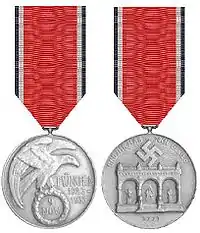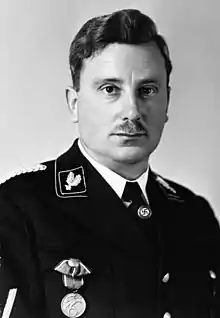Blood Order
The Blood Order (German: Blutorden), officially known as the Decoration in Memory of 9 November 1923[lower-alpha 1] (Medaille zur Erinnerung an den 9. November 1923), was one of the most prestigious decorations in the Nazi Party (NSDAP). During March 1934, Hitler authorized the Blood Order to commemorate the 9 November 1923 coup attempt of the Nazi Party.[1] The medal is silver, with the obverse bearing a depiction of an eagle grasping an oak leaf wreath. Inside the wreath is the date 9.Nov. and to the right is the inscription München 1923–1933. The reverse shows the entrance of the Feldherrnhalle in relief (where the coup ended in defeat), and directly above is the angled swastika with sun rays in the background. Along the top edge is the inscription: UND IHR HABT DOCH GESIEGT ("And after all, you won").[2]
| Decoration in Memory of 9 November 1923 Medaille zur Erinnerung an den 9. November 1923 | |
|---|---|
 The Blood Order medal | |
| Type | Political decoration |
| Awarded for | Participants in the 1923 putsch and members of the party or one of its formations before January 1932 |
| Country | Germany |
| Presented by | The Nazi Party |
| Eligibility | Members of the Nazi Party or cadets from the Munich Infantry School who marched in support of the Hitler-Ludendorff-Putsch |
| Status | Obsolete, illegal |
| Established | March 1934 |
Ribbon bar of the NSDAP Blood Order | |


History
The first issue of the decoration, struck in 99% pure silver, was awarded to 1,500 participants in the putsch who had also been members of the Nazi Party or one of its formations before January 1932 (continuous service), or had been cadets from the Munich Infantry School who marched in support of Ludendorff.[lower-alpha 2] All medals were numbered (except Hitler's and Göring's) and awarding was done very carefully. Unlike other medals, the ribbon was worn on the right breast of the uniform tunic in the form of a rosette and the medal sometimes was pinned on and suspended below.
In May 1938, to the dismay of the putsch participants, the award was extended to persons who had (a) served time in prison for Nazi activities before 1933, (b) received a death sentence which was later commuted to life imprisonment for Nazi activities before 1933, or (c) been severely wounded in the service of the Party before 1933; subsequently it was further extended to members of the Austrian Nazi Party who had participated in the 1934 February Uprising or July Putsch, or who had received significant prison time or injuries for Nazi activities. It could also be bestowed on certain other individuals at the discretion of Adolf Hitler, the last recipient being Reinhard Heydrich (posthumous).[3] These subsequent medals were struck in 80% silver with serial numbers above 1500 and did not carry the maker's name (J. FUESS MÜNCHEN) as the Type I medals did.
If a holder of this medal left the party, the medal would have to be relinquished.
In total 16 women received the award, two from the 'Altreich' (Eleonore Baur and Emma Schneider) and 14 from Austria. Given the number of original marchers in the putsch, the number of awards given under the 1938 extensions (436), and the awards for outstanding service under those same extensions, the total number of recipients numbered fewer than 6,000.
In November 1936, Hitler gave new "orders" for the "Orders and Awards" of Nazi Germany. The top NSDAP awards are listed in this order: 1. Coburg Badge; 2. Nürnberg Party Badge of 1929; 3. SA Treffen at Brunswick 1931; 4. Golden Party Badge; 5. Blood Order; followed by the Gau badges and the Golden HJ Badge.[4][5]
Selected recipients
- Max Amann
- Eleonore Baur
- Joseph Berchtold
- Johannes Block
- Martin Bormann
- Kuno-Hans von Both
- Philipp Bouhler
- Wilhelm Bruckner
- Walter Buch
- Karl-Heinz Bürger
- Kurt Daluege
- Eduard Dietl
- Sepp Dietrich
- Franz Xaver Dorsch
- Anton Drexler
- Hermann Esser
- Karl Fiehler
- Josef Fitzthum
- Hans Frank
- Wilhelm Frick
- Albert Ganzenmüller
- Ernst Girzick
- Hermann Göring
- Ulrich Graf
- Jakob Grimminger
- Edmund Heines
- Walter Hewel
- Reinhard Heydrich (posthumous, June 1942)
- Heinrich Himmler (withdrawn, April 1945)
- Friedrich Hildebrandt
- Hans Hinkel
- Adolf Hitler
- Adolf Hühnlein
- Ernst Kaltenbrunner
- Emil Ketterer
- Günther Korten
- Werner Kreipe
- Theodor Kretschmer
- Wilhelm Friedrich Loeper
- Erich Ludendorff
- Emil Maurice
- Josef Albert Meisinger
- Heinz Pernet
- Karl-Jesko von Puttkamer
- Helmuth Raithel
- Friedrich Josef Rauch
- Ernst Röhm
- Alfred Rosenberg
- Julian Scherner
- Julius Schreck
- Walter Schultze
- Franz Xaver Schwarz
- Franz Schwede
- Julius Streicher
- Adolf Wagner
- Robert Heinrich Wagner
- Karl Wahl
- Friedrich Weber
- Wilhelm Weiss
References
Notes
- The date of the Munich putsch
- Since it was illegal under the Weimar Republic for members of the Armed Forces to belong to political parties, the former cadets, as military officers, would have been unable to join the Nazi Party. Most of the cadet recipients were never in fact Nazis.
Citations
- Doehle 1995, p. 71.
- Doehle 1995, p. 72.
- Williams 2003, p. 223.
- Dombrowski 1940.
- Angolia 1989, p. 197.
Bibliography
- Angolia, John (1989). For Führer and Fatherland: Political & Civil Awards of the Third Reich. R. James Bender Publishing. ISBN 978-0-912-13816-9.
- Doehle, Heinrich (1995) [1943]. Medals & Decorations of the Third Reich: Badges, Decorations, Insignia. Reddick Enterprises. ISBN 0962488348.
- Dombrowski, Hanns (1940). Orders, Ehrenzeichen und Titel.
- Williams, Max (2003). Reinhard Heydrich: The Biography, Volume 2—Enigma. Church Stretton: Ulric Publishing. ISBN 978-0-9537577-6-3.
Further reading
- Nimmergut, Jörg (1980). Orden & Ehrenzeichen 1800-1945, Deutschland-Katalog. Munich.
{{cite book}}: CS1 maint: location missing publisher (link)